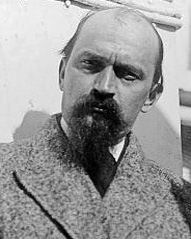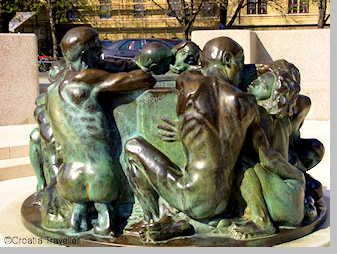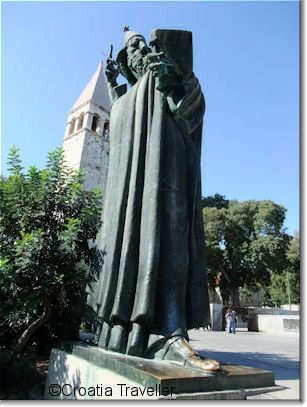Croatia's greatest 20th century sculptor was born in 1883 in the Sava valley and grew up in Otavice, a small village in the mountains northwest of Split. Ivan Mestrovic received no formal education but his artistic talent drew the attention of a stonecutter in Split and at the age of 15 he was invited to live in the stonecutters workshop as an apprentice. After only nine months an Austrian mine-owner consented to pay for Mestrovic to study at the Vienna Academy of Art.
In 1904 he married Ruza Klein, the daughter of a Jewish merchant, and in 1905 received his first major commission: The Well of Life that stands outside the Croatian National Theatre in Zagreb. Its impressionism reflects the influence of the French sculptor, August Rodin, whom Mestrovic befriended in Vienna. In 1910 he participated in the Viennese Secession Exhibition where he attracted attention with his sculptures of south- Slavic heroes who had battled the Turks. His sculpture of the Serbian hero, Kraljevic Marko, now stands in the Mestrovic studio in Zagreb.
The choice of a Serbian hero reflected Mestrovic's commitment to a union of the southern Slavs. His political activism against the Austro-Hungarian empire forced him to flee Split in 1914 and move to Rome where he and two other Dalmatian activists organized the Yugoslav Committee on National Independence.
Fearful of the consequences of the treaty of London, in which Dalmatia would be given to Italy as a reward for entering WWI, the group moved to London to agitate for independence. A Mestrovic one- man show in the Victoria and Albert Museum in London helped publicize their cause and secure popular support in Britain for the post war Kingdom of Serbs Croats and Slovenes.
After WWI Mestrovic returned to Zagreb and built a studio. His work turned away from political themes and from 1919 to 1922 he executed the Racic Memorial Chapel in Cavtat for the dying daughter of a ship owner. In 1926 he produced a monument of Gregorius of Nin and gave it to Split.
His first marriage ended in divorce and in nearby Dubrovnik Mestrovic met his second wife, Olga Kestercanek. In the 1930s he built a summer home for his wife and new family in Split which in accordance with his wishes, has now become a museum of his work. In his hometown of Otavice, he built the Church of the Holy Redeemer which was to serve as the family mausoleum.
When the quisling government of Ante Pavelic, was installed in Zagreb in 1941, Mestrovic was pressured to cooperate with the regime but he refused and was imprisoned for almost five months. Although highly unpopular because of his ties with the Yugoslav Committee, his international reputation eventually forced Pavelic to release him. Mestrovic sought safety in Rome but was soon forced to flee again to Switzerland for the duration of the war.
Although Tito implored Mestrovic to return to post-war Yugoslavia, in 1946 the sculptor accepted a professorship at Syracuse University and sailed for the United States.
It was not his first visit. After a successful exhibition in 1924, Mestrovic received a commission for the Chicago Indians series which is his best known work in the United States. Soon after his arrival, the Metropolitan Museum of New York staged an exhibition of his work, the first time in its history that a living artist was honored with a one person show. Mestrovic became a United States citizen in 1954 and in 1955 became professor of sculpture at the University of Notre Dame in Indiana. In addition to bestowing number of his works to Syracuse and Indiana campuses, he sent 59 statues from the United States to Yugoslavia.
Mestrovic died in 1962 and was buried in the Church of the Holy Redeemer in Otavice. The town was occupied by Serbian rebels from 1991 to 1995. The Croatian forces that reclaimed the area in 1995 discovered that the church had been savagely attacked and the tombs desecrated. Reconstruction began promptly.
Join the Croatia Traveller Group
Recommended Experiences
©CroatiaTraveller 2005-2024 All rights reserved




 Croatian History
Croatian History Split Sights
Split Sights Cavtat
Cavtat